单片机控制系统外文翻译
- 格式:doc
- 大小:46.50 KB
- 文档页数:7
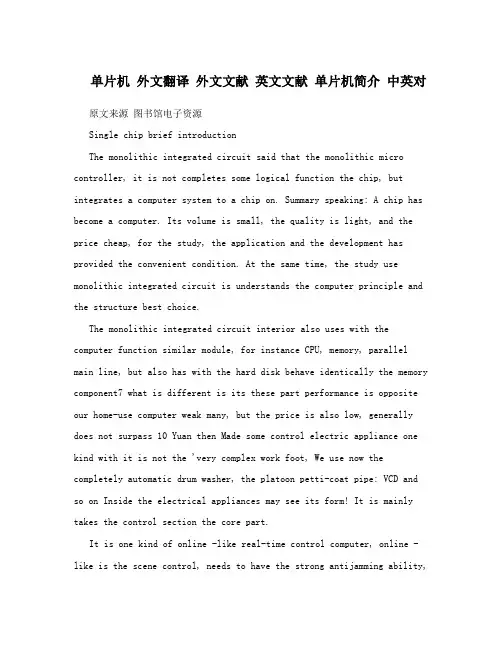
单片机外文翻译外文文献英文文献单片机简介中英对原文来源图书馆电子资源Single chip brief introductionThe monolithic integrated circuit said that the monolithic micro controller, it is not completes some logical function the chip, but integrates a computer system to a chip on. Summary speaking: A chip has become a computer. Its volume is small, the quality is light, and the price cheap, for the study, the application and the development has provided the convenient condition. At the same time, the study use monolithic integrated circuit is understands the computer principle and the structure best choice.The monolithic integrated circuit interior also uses with the computer function similar module, for instance CPU, memory, parallel main line, but also has with the hard disk behave identically the memory component7 what is different is its these part performance is opposite our home-use computer weak many, but the price is also low, generally does not surpass 10 Yuan then Made some control electric appliance one kind with it is not the 'very complex work foot, We use now the completely automatic drum washer, the platoon petti-coat pipe: VCD and so on Inside the electrical appliances may see its form! It is mainly takes the control section the core part.It is one kind of online -like real-time control computer, online -like is the scene control, needs to have the strong antijamming ability,the low cost, this is also and the off-line type computer (for instance home use PC,) main differenceThe monolithic integrated circuit is depending on the procedure, and may revise. Realizes the different function through the different procedure, particularly special unique some functions, this is other component needs to take the very big effort to be able to achieve, some are the flowered big strength is also very difficult to achieve. One is not the very complex function, if develops in the 50s with the US 74 series, or the 60s's CD4000 series these pure hardware do decides, the electric circuit certainly arc a big PCB board ! But if, if succeeded in the 70s with the US puts in the market the series monolithic integrated circuit, the result will have the huge difference. Because only the monolithic integrated circuit compiles through you the procedure may realize the high intelligence, high efficiency, as well as redundant reliabilityThe CPU is the key component of a digital computer. Its purpose isto decode instruction received from memory and perform transfers, arithmetic, logic, and control operations with data stored in internal registers, memory, or I/O interface units. Externally, the CPU provides one or more buses for transferring instructions, data, and control information to and from components connected to it. A microcontroller is present in the keyboard and in the monitor in the generic computer; thus these components are also shaded. In such microcontrollers, the CPU may be quite different from those discussed in this chapter. The wordlengths may be short, the number of registers small, and the instruction sets limited. Performance, relatively speaking, is poor, but adequatefor the task. Most important, the cost of these microcontrollers is very low, making their use cost effective.Because the monolithic integrated circuit to the cost is sensitive, therefore present occupies the dominant status the software is the most preliminary assembly language7 it was except the binary machine code above the most preliminary language, sincewhy were such preliminary must use?Why high-level did the language already achieve the visualization programming level not to use? The reason is very simple, is the monolithic integrated circuit docs not have home computer such CPU, and also has not looked like the hard disk such mass memory equipment. Inside even if a visualization higher order language compilation script only then a button, also will achieve several dozens K the sizes! Does not speak anything regarding the home use PC hard disk, but says regarding the monolithic integrated circuit cannot accept. The monolithic integrated circuit in the hardware source aspect's use factor must very Gao Caixing, therefore assembly, although primitive actually massively is using, Same truth, if attains supercomputer's on operating system and the application software home use PC to come up the movement, home use PC could also not withstand.It can be said that the 20th century surmounted three "the electricity" the time, namely the electrical time, the Electronic Ageand already entered computer time. However, this kind of computer, usually refers to the personal computer, is called PC machine. It by the main engine, the keyboard, the monitor and so on is composed. Also has a kind of computer, most people actually not how familiar. This kind of computer is entrusts with the intelligence each kind of mechanical monolithic integrated circuit (also to call micro controller). , This kind of computer's smallest system only has used as the name suggests a piece of integrated circuit, then carries on the simple operation and the control. Because its volume is small, usually hides in is accused the machinery "the belly". It in the entire installment, plays is having like the human brains role, it went wrong, the entire installment paralyzed. Now, this kind of monolithic integrated circuit's use domain already very widespread, like the intelligent measuring appliance, the solid work paid by time control, the communication equipment, the guidance system, the domestic electric appliances and so on, Once each product used the monolithic integrated circuit, could get up causes the effect which the product turned to a new generation, often before product range crown by adjective---- …intelligence?, like intelligence washer and so on. Now some factory's technical personnel or other extra-curricular electronic exploiter do certain products, are not theelectric circuit are too complex, is the function is too simple, and is imitated extremely easily. Investigates its reason, possibly on card, in the product has not used on the monolithic integrated circuit or other programmable logical component.单片机简介单片机又称单片微控制器,它不是完成某一个逻辑功能的芯片,而是把一个计算机系统集成到一个芯片上。
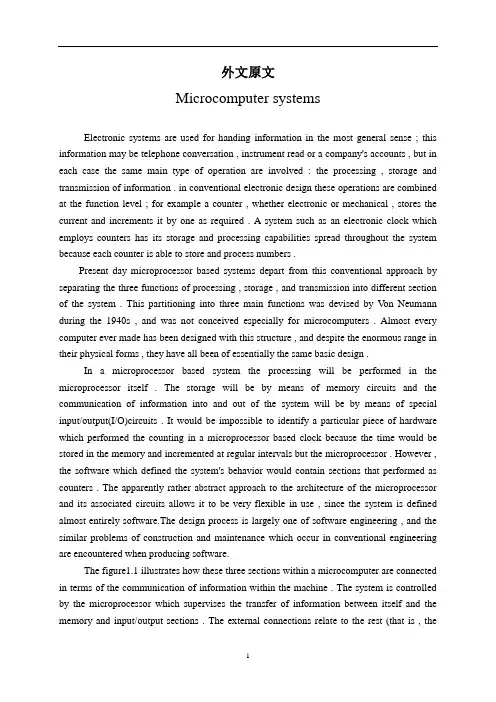
外文原文Microcomputer systemsElectronic systems are used for handing information in the most general sense ; this information may be telephone conversation , instrument read or a company's accounts , but in each case the same main type of operation are involved : the processing , storage and transmission of information . in conventional electronic design these operations are combined at the function level ; for example a counter , whether electronic or mechanical , stores the current and increments it by one as required . A system such as an electronic clock which employs counters has its storage and processing capabilities spread throughout the system because each counter is able to store and process numbers .Present day microprocessor based systems depart from this conventional approach by separating the three functions of processing , storage , and transmission into different section of the system . This partitioning into three main functions was devised by V on Neumann during the 1940s , and was not conceived especially for microcomputers . Almost every computer ever made has been designed with this structure , and despite the enormous range in their physical forms , they have all been of essentially the same basic design .In a microprocessor based system the processing will be performed in the microprocessor itself . The storage will be by means of memory circuits and the communication of information into and out of the system will be by means of special input/output(I/O)circuits . It would be impossible to identify a particular piece of hardware which performed the counting in a microprocessor based clock because the time would be stored in the memory and incremented at regular intervals but the microprocessor . However , the software which defined the system's behavior would contain sections that performed as counters . The apparently rather abstract approach to the architecture of the microprocessor and its associated circuits allows it to be very flexible in use , since the system is defined almost entirely software.The design process is largely one of software engineering , and the similar problems of construction and maintenance which occur in conventional engineering are encountered when producing software.The figure1.1 illustrates how these three sections within a microcomputer are connected in terms of the communication of information within the machine . The system is controlled by the microprocessor which supervises the transfer of information between itself and the memory and input/output sections . The external connections relate to the rest (that is , thenon-computer part) of the engineering system.Fig.1.1 Three Sections of a Typical MicrocomputerAlthough only one storage section has been shown in the diagram , in practice two distinct types of memory RAM and ROM are used . In each case , the word 'memory' is rather inappropriate since a computers memory is more like a filing cabinet in concept ; information is stored in a set of numbered 'boxes' and it is referenced by the serial number of the 'box' in question .Microcomputers use RAM (Random Access Memory) into which data can be written and from which data can be read again when needed . This data can be read back from the memory in any sequence desired , and not necessarily the same order in which it was written , hence the expression 'random' access memory . Another type of ROM (Read Only memory) is used to hold fixed patterns of information which cannot be affected by the microprocessor ; these patterns are not lost when power is removed and are normally used to hold the program which defines the behavior of a microprocessor based system. ROMs can be read like RAMs , but unlike RAMs they cannot be used to store variable information . Some ROMs have their data patterns put in during manufacture , while others are programmable by the user by means of special equipment and are called programmable ROMs . The widely used programmable ROMs are erasable by means of special ultraviolet lamps and are referred to as EPROMs , short for Erasable Programmable Read Only Memories . Other new types of device can be erased electrically without the need for ultraviolet light, which are called Electrically Erasable Programmable Read Only Memories , EEPROMs.The microprocessor processes data under the control of the program , controlling the flow of information to and from memory and input/output devices . Some input/output devices are general-purpose types while others are designed for controlling special hardware such as disc drives or controlling information transmission to other computers . Most types of I/O devices are programmable to some extent , allowing different modes of operation , while some actually contain special-purpose microprocessors to permit quite complex operations to be carried out without directly involving the main microprocessor .The microprocessor processes data under the control of the program , controlling the Memory(ROM,RAM) Microproce I/Ointerfaceflow of information to and from memory and input/output devices . Some input/output devices are general-purpose types while others are designed for controlling special hardware such as disc drives or controlling information transmission to other computers . Most types of I/O devices are programmable to some extent , allowing different modes of operation , while some actually contain special-purpose microprocessors to permit quite complex operations to be carried out without directly involving the main microprocessor .The microprocessor , memory and input/output circuit may all be contained on the same integrated circuit provided that the application does not require too much program or data storage. This is usually the case in low-cost application such as the controllers used in microwave ovens and automatic washing machines . The use of single package allows considerable cost savings to e made when articles are manufactured in large quantities . As technology develops , more and more powerful processors and larger and larger amounts of memory are being incorporated into single chip microcomputers with resulting saving in assembly costs in the final products . For the foreseeable future , however , it will continue to be necessary to interconnect a number of integrated circuits to make a microcomputer whenever larger amounts of storage or input/output are required.Another major engineering application of microcomputers is in process control . Here the presence of the microcomputer is usually more apparent to the user because provision is normally made for programming the microcomputer for the particular application . In process control applications the benefits if fitting the entire system on to single chip are usually outweighed by the high design cost involved , because this sort if equipment is produced in smaller quantities . Moreover , process controllers are usually more complicated so that it is more difficult to make them as single integrated circuits . Two approaches are possible ; the controller can be implemented as a general-purpose microcomputer rather like a more robust version if a hobby computer , or as a 'packaged' system , signed for replacing controllers based on older technologies such as electromagnetic relays . In the former case the system would probably be programmed in conventional programming languages such as the ones to 9 be introduced later , while in the other case a special-purpose language might be used , for example one which allowed the function of the controller to be described in terms of relay interconnections . In either case programs can be stored in RAM , which allows them to be altered to suit changes in application , but this makes the overall system vulnerable to loss if power unless batteries are used to ensure continuity of supply . Alternatively programs can be stored in ROM , in which case they virtually become part of the electronic 'hardware' and are often referred to as firmware . More sophisticated process controllers require minicomputers for their implementation , although the use if large scale integrated circuits the distinctionbetween mini and microcomputers . Products and process controllers of various kinds represent the majority of present-day microcomputer applications , the exact figures depending on one's interpretation of the word 'product'. Virtually all engineering and scientific uses of microcomputers can be assigned to one or other of these categories . But in the system we most study Pressure and Pressure Transmitters . Pressure arises when a force is applied over an area . Provided the force is one Newton and uniformly over the area of one square meters , the pressure has been designated one Pascal . Pressure is a universal processing condition . It is also a condition of life on the plant : we live at the bottom of an atmospheric ocean that extends upward for many miles . This mass of air has weight , and this weight pressing downward causes atmospheric pressure . Water , a fundamental necessity of life , is supplied to most of us under pressure . In the typical process plant , pressure influences boiling point temperatures , condensing point temperatures , process efficiency , costs , and other important factors . The measurement and control of pressure or lack of it-vacuum-in the typical process plant is critical.The working instruments in the plant usually include simple pressure gauges , precision recorders and indicators , and pneumatic and electronic pressure transmitters . A pressure transmitter makes a pressure measurement and generates either a pneumatic or electrical signal output that is proportional to the pressure being sensed .In the process plant , it is impractical to locate the control instruments out in the place near the process . It is also true that most measurements are not easily transmitted from some remote location . Pressure measurement is an exception , but if a high pressure of some dangerous chemical is to be indicated or recorded several hundred feet from the point of measurement , a hazard may be from the pressure or from the chemical carried.To eliminate this problem , a signal transmission system was developed . This system is usually either pneumatic or electrical . And control instruments in one location . This makes it practical for a minimum number of operators to run the plant efficiently .When a pneumatic transmission system is employed , the measurement signal is converted into pneumatic signal by the transmitter scaled from 0 to 100 percent of the measurement value . This transmitter is mounted close to the point of measurement in the process . The transmitter output-air pressure for a pneumatic transmitter-is piped to the recording or control instrument . The standard output range for a pneumatic transmitter is 20 to 100kPa , which is almost universally used .When an electronic pressure transmitter is used , the pressure is converted to electrical signal that may be current or voltage . Its standard range is from 4 to 20mA DC for current signal or from 1 to 5V DC for voltage signal . Nowadays , another type of electrical signal ,kPamA kPa mA kPa kPa mA mA Kr 027.0600160600420==--=which is becoming common , is the digital or discrete signal . The use of instruments and control systems based on computer or forcing increased use of this type of signal .Sometimes it is important for analysis to obtain the parameters that describe the sensor/transmitter behavior . The gain is fairly simple to obtain once the span is know . Consider an electronic pressure transmitter with a range of 0~600kPa . The gain isdefined as the change in output divided by the change in input . In this case , the output is electrical signal (4~20mA DC) and the input is process pressure (0~600kPa) . Thus the gain . Beside we must measure Temperature Temperature measurement is important in industrial control , as direct indications of system or product state and as indirect indications of such factors as reaction rates , energy flow , turbine efficiency . and lubricant quality . Present temperature scales have been in use for about 200 years ,the earliest instruments were based on the thermal expansion of gases and liquids . Such filled systems are still employed , although many other types of instruments are available . Representative temperature sensors include: filled thermal systems , liquid-in-glass thermometers , thermocouples , resistance temperature detectors , thermostats , bimetallic devices , optical and radiation pyrometers and temperature-sensitive paints .Advantages of electrical systems include high accuracy and sensitivity , practicality of switching or scanning several measurements points , larger distances possible between measuring elements and controllers , replacement of components (rather than complete system) , fast response , and ability to measure higher temperature . Among the electrical temperature sensors , thermocouples and resistance temperature detectors are most widely used .中文翻译单片机系统广义地说,微处理系统是用于处理信息的,这种信息可以是电话交谈,仪器读数或企业帐户,但是各种情况下都涉及相同的主要操作;信息处理、存储和传递。
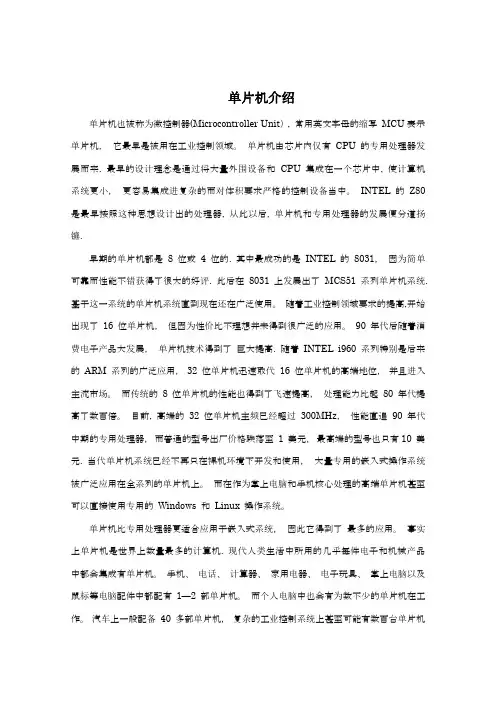
单片机介绍单片机也被称为微控制器(Microcontroller Unit), 常用英文字母的缩写MCU表示单片机,它最早是被用在工业控制领域。
单片机由芯片内仅有CPU 的专用处理器发展而来. 最早的设计理念是通过将大量外围设备和CPU 集成在一个芯片中, 使计算机系统更小,更容易集成进复杂的而对体积要求严格的控制设备当中。
INTEL 的Z80是最早按照这种思想设计出的处理器, 从此以后, 单片机和专用处理器的发展便分道扬镳.早期的单片机都是8 位或 4 位的. 其中最成功的是INTEL 的8031,因为简单可靠而性能不错获得了很大的好评. 此后在8031 上发展出了MCS51 系列单片机系统.基于这一系统的单片机系统直到现在还在广泛使用。
随着工业控制领域要求的提高,开始出现了16 位单片机,但因为性价比不理想并未得到很广泛的应用。
90 年代后随着消费电子产品大发展,单片机技术得到了巨大提高. 随着INTEL i960 系列特别是后来的ARM 系列的广泛应用,32 位单片机迅速取代16 位单片机的高端地位,并且进入主流市场。
而传统的8 位单片机的性能也得到了飞速提高,处理能力比起80 年代提高了数百倍。
目前, 高端的32 位单片机主频已经超过300MHz,性能直追90 年代中期的专用处理器,而普通的型号出厂价格跌落至1 美元,最高端的型号也只有10 美元. 当代单片机系统已经不再只在裸机环境下开发和使用,大量专用的嵌入式操作系统被广泛应用在全系列的单片机上。
而在作为掌上电脑和手机核心处理的高端单片机甚至可以直接使用专用的Windows 和Linux 操作系统。
单片机比专用处理器更适合应用于嵌入式系统,因此它得到了最多的应用。
事实上单片机是世界上数量最多的计算机. 现代人类生活中所用的几乎每件电子和机械产品中都会集成有单片机。
手机、电话、计算器、家用电器、电子玩具、掌上电脑以及鼠标等电脑配件中都配有1—2 部单片机。
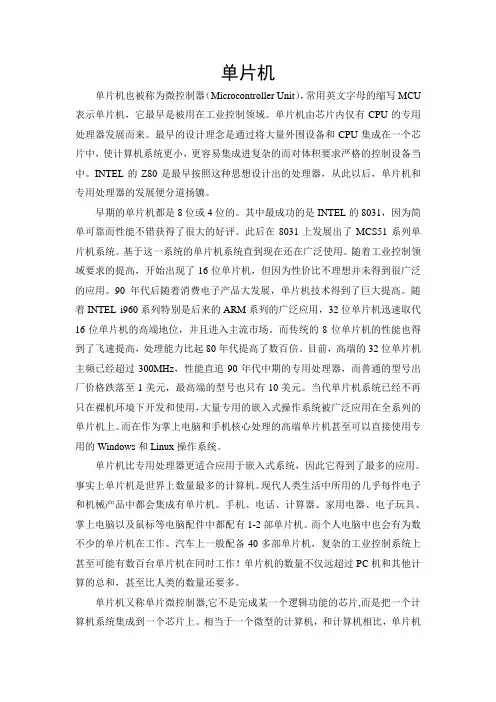
单片机单片机也被称为微控制器(Microcontroller Unit),常用英文字母的缩写MCU 表示单片机,它最早是被用在工业控制领域。
单片机由芯片内仅有CPU的专用处理器发展而来。
最早的设计理念是通过将大量外围设备和CPU集成在一个芯片中,使计算机系统更小,更容易集成进复杂的而对体积要求严格的控制设备当中。
INTEL的Z80是最早按照这种思想设计出的处理器,从此以后,单片机和专用处理器的发展便分道扬镳。
早期的单片机都是8位或4位的。
其中最成功的是INTEL的8031,因为简单可靠而性能不错获得了很大的好评。
此后在8031上发展出了MCS51系列单片机系统。
基于这一系统的单片机系统直到现在还在广泛使用。
随着工业控制领域要求的提高,开始出现了16位单片机,但因为性价比不理想并未得到很广泛的应用。
90年代后随着消费电子产品大发展,单片机技术得到了巨大提高。
随着INTEL i960系列特别是后来的ARM系列的广泛应用,32位单片机迅速取代16位单片机的高端地位,并且进入主流市场。
而传统的8位单片机的性能也得到了飞速提高,处理能力比起80年代提高了数百倍。
目前,高端的32位单片机主频已经超过300MHz,性能直追90年代中期的专用处理器,而普通的型号出厂价格跌落至1美元,最高端的型号也只有10美元。
当代单片机系统已经不再只在裸机环境下开发和使用,大量专用的嵌入式操作系统被广泛应用在全系列的单片机上。
而在作为掌上电脑和手机核心处理的高端单片机甚至可以直接使用专用的Windows和Linux操作系统。
单片机比专用处理器更适合应用于嵌入式系统,因此它得到了最多的应用。
事实上单片机是世界上数量最多的计算机。
现代人类生活中所用的几乎每件电子和机械产品中都会集成有单片机。
手机、电话、计算器、家用电器、电子玩具、掌上电脑以及鼠标等电脑配件中都配有1-2部单片机。
而个人电脑中也会有为数不少的单片机在工作。
汽车上一般配备40多部单片机,复杂的工业控制系统上甚至可能有数百台单片机在同时工作!单片机的数量不仅远超过PC机和其他计算的总和,甚至比人类的数量还要多。
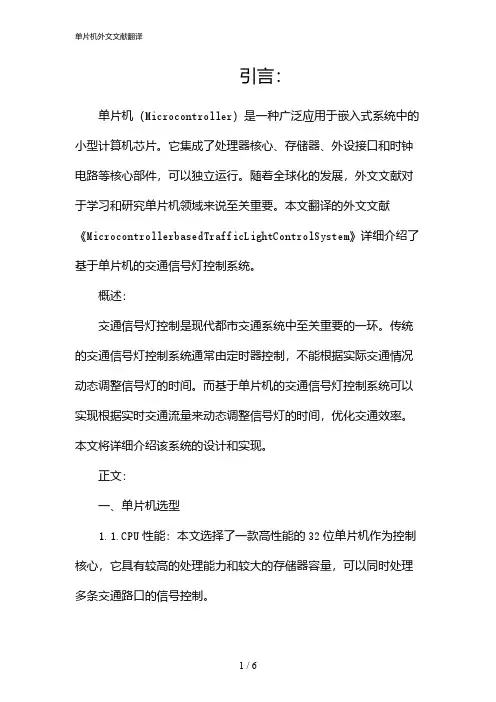
引言:单片机(Microcontroller)是一种广泛应用于嵌入式系统中的小型计算机芯片。
它集成了处理器核心、存储器、外设接口和时钟电路等核心部件,可以独立运行。
随着全球化的发展,外文文献对于学习和研究单片机领域来说至关重要。
本文翻译的外文文献《MicrocontrollerbasedTrafficLightControlSystem》详细介绍了基于单片机的交通信号灯控制系统。
概述:交通信号灯控制是现代都市交通系统中至关重要的一环。
传统的交通信号灯控制系统通常由定时器控制,不能根据实际交通情况动态调整信号灯的时间。
而基于单片机的交通信号灯控制系统可以实现根据实时交通流量来动态调整信号灯的时间,优化交通效率。
本文将详细介绍该系统的设计和实现。
正文:一、单片机选型1.1.CPU性能:本文选择了一款高性能的32位单片机作为控制核心,它具有较高的处理能力和较大的存储器容量,可以同时处理多条交通路口的信号控制。
1.2.外设接口:该单片机具有丰富的外设接口,可以与交通信号灯、传感器和通信设备等进行连接,实现信号控制和数据交互。
1.3.低功耗设计:为了节约能源和延长系统寿命,在单片机选型时考虑了低功耗设计,降低系统运行的能耗。
二、硬件设计2.1.交通信号灯:在设计交通信号灯时,考虑了日夜可见性和能耗。
采用了高亮度LED作为信号灯光源,同时添加了光敏传感器控制信号灯的亮度,以满足不同时间段的亮度需求。
2.2.传感器:通过安装车辆感应器和行人感应器等传感器,可以在实时监测交通流量的基础上,智能调整信号灯时间,提高路口的交通效率。
2.3.通信设备:在交通信号灯控制系统中引入了通信设备,可以实现各交通路口之间的信息交互和协调控制,提高整体交通系统的效率。
三、软件设计3.1.程序架构:采用了多任务的实时操作系统,将交通信号灯控制、传感器数据处理和通信设备控制等功能分别封装成不同的任务,实现了系统的高效运行和任务调度。
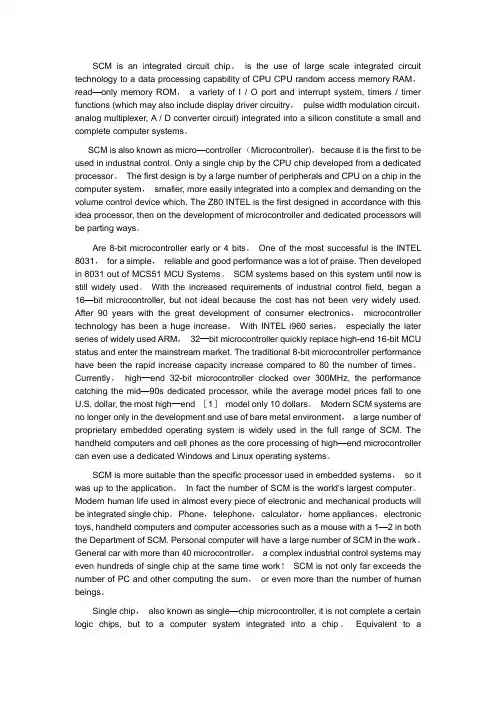
SCM is an integrated circuit chip,is the use of large scale integrated circuit technology to a data processing capability of CPU CPU random access memory RAM,read—only memory ROM,a variety of I / O port and interrupt system, timers / timer functions (which may also include display driver circuitry,pulse width modulation circuit,analog multiplexer, A / D converter circuit) integrated into a silicon constitute a small and complete computer systems。
SCM is also known as micro—controller (Microcontroller),because it is the first to be used in industrial control. Only a single chip by the CPU chip developed from a dedicated processor。
The first design is by a large number of peripherals and CPU on a chip in the computer system,smaller, more easily integrated into a complex and demanding on the volume control device which. The Z80 INTEL is the first designed in accordance with this idea processor, then on the development of microcontroller and dedicated processors will be parting ways。
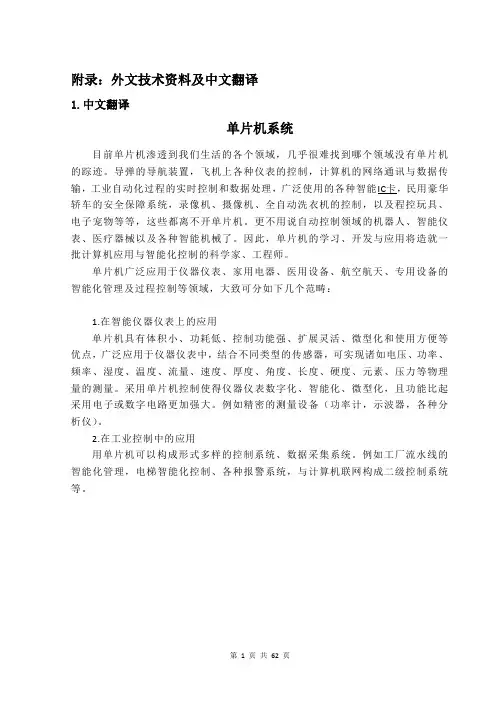
附录:外文技术资料及中文翻译1.中文翻译单片机系统目前单片机渗透到我们生活的各个领域,几乎很难找到哪个领域没有单片机的踪迹。
导弹的导航装置,飞机上各种仪表的控制,计算机的网络通讯与数据传输,工业自动化过程的实时控制和数据处理,广泛使用的各种智能IC卡,民用豪华轿车的安全保障系统,录像机、摄像机、全自动洗衣机的控制,以及程控玩具、电子宠物等等,这些都离不开单片机。
更不用说自动控制领域的机器人、智能仪表、医疗器械以及各种智能机械了。
因此,单片机的学习、开发与应用将造就一批计算机应用与智能化控制的科学家、工程师。
单片机广泛应用于仪器仪表、家用电器、医用设备、航空航天、专用设备的智能化管理及过程控制等领域,大致可分如下几个范畴:1.在智能仪器仪表上的应用单片机具有体积小、功耗低、控制功能强、扩展灵活、微型化和使用方便等优点,广泛应用于仪器仪表中,结合不同类型的传感器,可实现诸如电压、功率、频率、湿度、温度、流量、速度、厚度、角度、长度、硬度、元素、压力等物理量的测量。
采用单片机控制使得仪器仪表数字化、智能化、微型化,且功能比起采用电子或数字电路更加强大。
例如精密的测量设备(功率计,示波器,各种分析仪)。
2.在工业控制中的应用用单片机可以构成形式多样的控制系统、数据采集系统。
例如工厂流水线的智能化管理,电梯智能化控制、各种报警系统,与计算机联网构成二级控制系统等。
3.在家用电器中的应用可以这样说,现在的家用电器基本上都采用了单片机控制,从电饭煲、洗衣机、电冰箱、空调机、彩电、其他音响视频器材、再到电子秤量设备,五花八门,无所不在。
4.在计算机网络和通信领域中的应用现代的单片机普遍具备通信接口,可以很方便地与计算机进行数据通信,为在计算机网络和通信设备间的应用提供了极好的物质条件,现在的通信设备基本上都实现了单片机智能控制,从手机,电话机、小型程控交换机、楼宇自动通信呼叫系统、列车无线通信、再到日常工作中随处可见的移动电话,集群移动通信,无线电对讲机等。
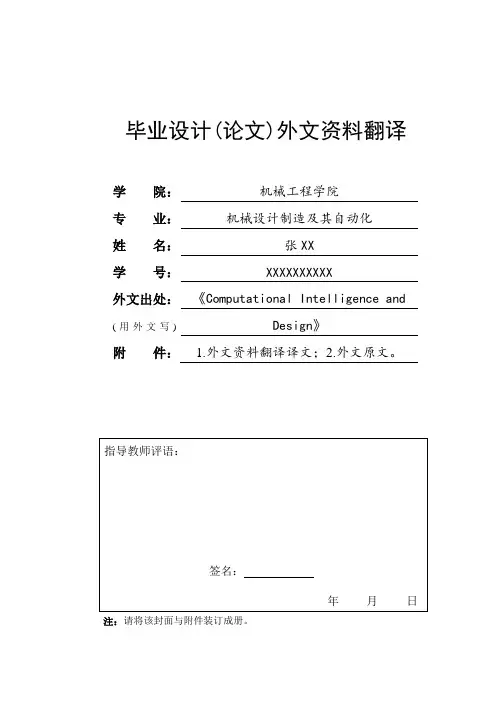
毕业设计(论文)外文资料翻译学院:机械工程学院专业:机械设计制造及其自动化姓名:张XX学号:XXXXXXXXXX外文出处:《Computational Intelligence and (用外文写)Design》附件: 1.外文资料翻译译文;2.外文原文。
注:请将该封面与附件装订成册。
附件1:外文资料翻译译文基于微型计算机的步进电机控制系统设计孟天星余兰兰山东理工大学电子与电气工程学院山东省淄博市摘要本文详细地介绍了一种以AT89C51为核心的步进电机控制系统。
该系统设计包括硬件设计、软件设计和电路设计。
电路设计模块包括键盘输入模块、LED显示模块、发光二极管状态显示和报警模块。
按键可以输入设定步进电机的启停、转速、转向,改变转速、转向等的状态参数。
通过键盘输入的状态参数来控制步进电机的步进位置和步进速度进而驱动负载执行预订的工作。
运用显示电路来显示步进电机的输入数据和运行状态。
AT89C51单片机通过指令系统和编译程序来执行软件部分。
通过反馈检测模块,该系统可以很好地完成上述功能。
关键词:步进电机,AT89C51单片机,驱动器,速度控制1概述步进电机因为具有较高的精度而被广泛地应用于运动控制系统,例如机器人、打印机、软盘驱动机、绘图仪、机械式阀体等等。
过去传统的步进电机控制电路和驱动电路设计方法通常都极为复杂,由成本很高而且实用性很差的电器元件组成。
结合微型计算机技术和软件编程技术的设计方法成功地避免了设计大量复杂的电路,降低了使用元件的成本,使步进电机的应用更广泛更灵活。
本文步进电机控制系统是基于AT89C51单片机进行设计的,它具有电路简单、结构紧凑的特点,能进行加减速,转向和角度控制。
它仅仅需要修改控制程序就可以对各种不同型号的步进电机进行控制而不需要改变硬件电路,所以它具有很广泛的应用领域。
2设计方案该系统以AT89C51单片机为核心来控制步进电机。
电路设计包括键盘输入电路、LED显示电路、发光二极管显示电路和报警电路,系统原理框图如图1所示。
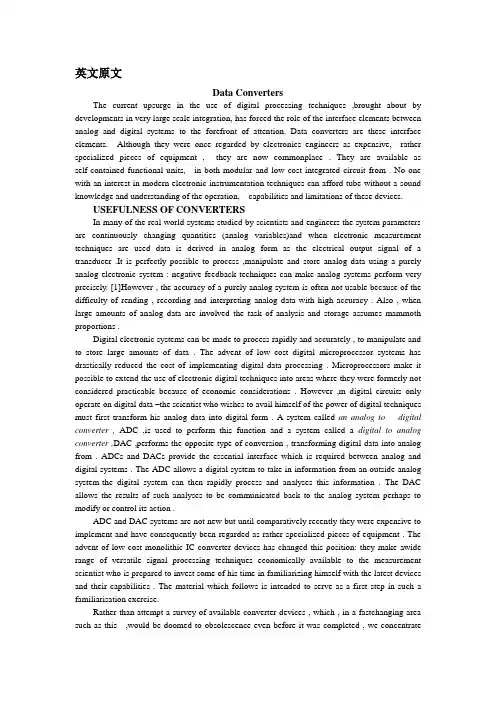
英文原文Data ConvertersThe current upsurge in the use of digital processing techniques ,brought about by developments in very large scale integration, has forced the role of the interface elements between analog and digital systems to the forefront of attention. Data converters are these interface elements. Although they were once regarded by electronics engineers as expensive, rather specialized pieces of equipment , they are now commonplace . They are available as self-contained functional units, in both modular and low cost integrated circuit from . No one with an interest in modern electronic instrumentation techniques can afford tube without a sound knowledge and understanding of the operation, capabilities and limitations of these devices.USEFULNESS OF CONVERTERSIn many of the real world systems studied by scientists and engineers the system parameters are continuously changing quantities (analog variables)and when electronic measurement techniques are used data is derived in analog form as the electrical output signal of a transducer .It is perfectly possible to process ,manipulate and store analog data using a purely analog electronic system : negative feedback techniques can make analog systems perform very precisely. [1]However , the accuracy of a purely analog system is often not usable because of the difficulty of rending , recording and interpreting analog data with high accuracy . Also , when large amounts of analog data are involved the task of analysis and storage assumes mammoth proportions .Digital electronic systems can be made to process rapidly and accurately , to manipulate and to store large amounts of data . The advent of low cost digital microprocessor systems has drastically reduced the cost of implementing digital data processing . Microprocessors make it possible to extend the use of electronic digital techniques into areas where they were formerly not considered practicable because of economic considerations . However ,m digital circuits only operate on digital data –the scientist who wishes to avail himself of the power of digital techniques must first transform his analog data into digital form . A system called an analog to digital converter , ADC ,is used to perform this function and a system called a digital to analog converter ,DAC ,performs the opposite type of conversion , transforming digital data into analog from . ADCs and DACs provide the essential interface which is required between analog and digital systems . The ADC allows a digital system to take in information from an outside analog system-the digital system can then rapidly process and analyses this information . The DAC allows the results of such analyses to be communicated back to the analog system perhaps to modify or control its action .ADC and DAC systems are not new but until comparatively recently they were expensive to implement and have consequently been regarded as rather specialized pieces of equipment . The advent of low cost monolithic IC converter devices has changed this position: they make awide range of versatile signal processing techniques economically available to the measurement scientist who is prepared to invest some of his time in familiarizing himself with the latest devices and their capabilities . The material which follows is intended to serve as a first step in such a familiarisation exercise.Rather than attempt a survey of available converter devices , which , in a fastchanging area such as this ,would be doomed to obsolescence even before it was completed , we concentrateon the principles underlying the most popular conversion techniques . Specific IC devices are mentioned , but only as a means of relating the discussion to practical circuits which you can experimentally evaluate for yourself-there is no substitute for ‘hands on ’ practical experience in this type of learning exercise . However , it should not be assumed that the devices referred to are he only ones , nor indeed the ‘best’ones available (from a cost /performance standpoint). The choice of the ‘best’ converter for a specific application can only be made from athorough study of the manufacturers’ latest product guides .ANALOG TO DIGITAL CONVERSION TECHNIQUSComparison Of A/D Conversion TechniquesA brief summary is now given in which the main characteristics of devices which use the various conversion techniques that have been discussed will be compared . There are normally there dominant factors which govern the choice of the A/D converter to be used in an application : speed , accuracy and cost . It is convenient to compare the different techniques in relation to these three factors .Speed limitations are inherent in the particular techniques but arrange of speeds can be expected for different converter devices using the same conversion technique . A speed/accuracy design compromise is inherent in all the conversion techniques . Increase accuracy is obtained at the expense of a reduction in conversion speed . In general , cost is directly related to speed and accuracy , but the cost of a converter device(indeed of any device) , is greatly influenced by market factors which might be quit unrelated to the performance of the device . The bigger the market is , the more firms there will be attempting to get a slice of it , and competition brings down the cost .As far as inherent speed imitations are concerned the techniques discussed in this chapter in order of decreasing speed (increase in conversion time )are : parallel conversion , successive approximation conversion , tracking conversion and integrating conversion .If sheer conversion speed is a dominating factor in an application , the designer will have to choose a converter which uses the parallel conversion technique . At the time of writing there are not many ultra-fast converters on the market and they tend to be expensive , particularly the higher resolution devices . Some firms which make very fast converters are TRW LSI Products , Datel-Intersil, Computer Labs and Motorola . Available parallel converters achieve an 8-bit conversion time of the order of 30ns . Applications in which conversion time must be very short are increasing for example, radar , digital TV and fast transient event recorders . [11,12] No doubt this growing range of applications will interest more manufacturers in very high speed converters and will result in a greater number of less costly devices appearing on the market.In converters which use the successive approximation technique conversion time is reated to the number of bits(to the resolution ) . The fastest successive approximation converters currently available are 8-bit devices which have a conversion time of the order of 0.8us. General purpose 8-bit devices may be expected to have conversion time of the order of 30us . High resolution 16-bit successive approximation converter modules have conversion times of the order of 400us .Successive approximation is probably the most widely used technique in the A/D converters which are currently available ; there are a large number of manufacturers making many different successive approximation devices . The successive approximation technique has more possible sources of error than the slower integrating techniques . The highest performance successive approximation converters are usually the discrete component modular type . Costs rise steeply ifthe application calls for state-of-the-art speed and accuracy . Successive approximation converters must be preceded by a sample/hold module when they are used to digitize rapidly changing analog signals(see section 5.3 ).Tracking converters , unlike successive approximation types , do not require an input sample/hold . Although they use simpler digital logic circuitry than successive approximation tyes they are subject to similar errors , but do not have the speed of a successive approximation converter preceded by a sample/hold(see section 5.8.5). There are comparatively few tracking or counting-type converters on the market compared with successive approximation and integrating types.Integrating converters are the slowest type but they are capable of very high accuracy . Conversion times of currently available integrating types range from 0.3 ms for a fast 8-bit converter to 250 ms for a slow 16-bit one .The integrating technique has the advantage of averaging-out noise components of the analog input signal whose frequencies are higher than the inverse of the integration period . Integrating converters do not require sample/holds. If the application is one in which the analog signals are slowly varying an integrating converter will provide the greatest accuracy for the least cost . Integrating converters are available from a large number of manufacturers .SUCCESSIVE APPROXIMATION A/D CONVERTERThe successive approximation A/D conversion technique provides a more rapid conversion than the other two feedback techniques . The digital logic circuitry used in this technique instead of incrementing the D/A converter output one LSB at time , performs a series of ‘trial ’conversions, In the first trial the control logic applies the MSB to the D/A converter and the analog output of the D/A converter (1/2 full scale) is compared with the analog input signal by the comparator . If the DAC’s output is less than the analog input the MSB is retained ; if the DAC’s output is greater than the analog input the MSB is switched OFF. The control logic then goes on to apply the nest MSB which is retained or discarded depending on the result of the comparison between the DAC’s output and analog input . The process of trying the addition of successively smaller bits and retaining or discarding them depending on the result of the trial , goes on until the LSB is reached ; the conversion is then complete .A simplified representation of the timing sequence which occurs in a typical 4-bit successive approximation A/D conversion is shown in figure .DIGITAL TO ANALOG CONVERTER APPLICATIONSUntil quite recently there has tended to be a clear distinction between analog and digital electronic systems . Functional operations such as amplification , wave-form generation , filtering , modulation and demodulation , etc ., have traditionally been regarded as purely analog operations ; In many cases the implementation of such functions has been founded on operational amplifier based circuitry .[1] Logical operations involved in process control and mathematical operations per-formed on abstract digital numbers have been the main area of application for digital electronic systems . Digital systems are founded on circuitry using gates , flip flops , counters , shift registers ,etc .One of the main reasons for the divisions of electronic systems between analog and digital has been the high cost of data converters . data converters are the essential interface components which allow analog and digital devices to word together . The inexpensive monolithic data converters which are now available make it economically viable to combine analog and digital devices . Such a converters permit a precise digital control to be added to analog functional applications ; they also allow many of the traditionally analog functional operations to be performed with circuitry based on digital devices . This chapter gives examples of some of the many analog/digital applications that are possible with the use of data converters .中文翻译数据转换器超大规模集成电路的发展,掀起了使用数字处理技术的高潮,促进人们必须重视模拟和数字系统间接口部件的作用。
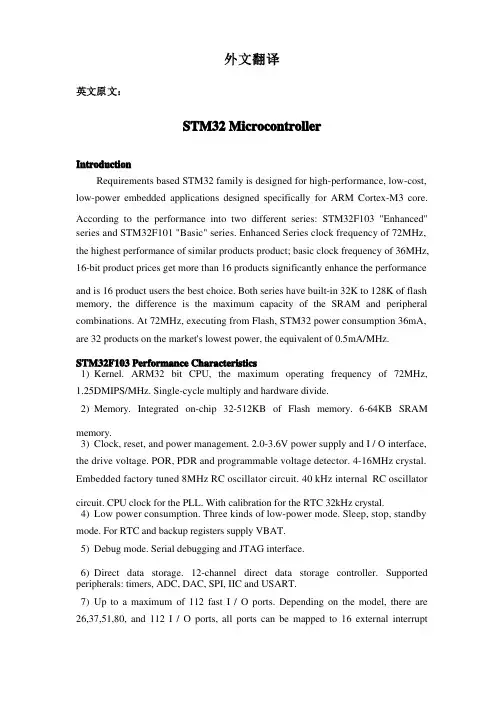
外文翻译英文原文:STM32 MicrocontrollerIntroductionRequirements based STM32 family is designed for high-performance, low-cost, low-power embedded applications designed specifically for ARM Cortex-M3 core. According to the performance into two different series: STM32F103 "Enhanced" series and STM32F101 "Basic" series. Enhanced Series clock frequency of 72MHz, the highest performance of similar products product; basic clock frequency of 36MHz, 16-bit product prices get more than 16 products significantly enhance the performance and is 16 product users the best choice. Both series have built-in 32K to 128K of flash memory, the difference is the maximum capacity of the SRAM and peripheral combinations. At 72MHz, executing from Flash, STM32 power consumption 36mA, are 32 products on the market's lowest power, the equivalent of 0.5mA/MHz.STM32F103 Performance Characteristics1) Kernel. ARM32 bit CPU, the maximum operating frequency of 72MHz,1.25DMIPS/MHz. Single-cycle multiply and hardware divide.2) Memory. Integrated on-chip 32-512KB of Flash memory. 6-64KB SRAMmemory.3) Clock, reset, and power management. 2.0-3.6V power supply and I / O interface, the drive voltage. POR, PDR and programmable voltage detector. 4-16MHz crystal. Embedded factory tuned 8MHz RC oscillator circuit. 40 kHz internal RC oscillator circuit. CPU clock for the PLL. With calibration for the RTC 32kHz crystal.4) Low power consumption. Three kinds of low-power mode. Sleep, stop, standby mode. For RTC and backup registers supply VBAT.5) Debug mode. Serial debugging and JTAG interface.6) Direct data storage. 12-channel direct data storage controller. Supported peripherals: timers, ADC, DAC, SPI, IIC and USART.7) Up to a maximum of 112 fast I / O ports. Depending on the model, there are 26,37,51,80, and 112 I / O ports, all ports can be mapped to 16 external interruptvectors. In addition to the analog input, all of them can accept the input of 5V or less.8) Up to a maximum of 11 timers. Four 16-bit timers, each with 4 IC / OC / PWM or pulse counter. 2 16 6-channel advanced control timer: up to 6 channels can be used for PWM output. 2 watchdog timer. Systick timer: 24 down counter. Two 16-bit basic timer for driving DAC.9) Up to a maximum of 13 communication interfaces. 2 IIC interface. 5 USART interfaces. 3 SPI interface, two and IIS reuse. CAN interface. USB 2.0 full-speed interface. SDIO interface.System Function1) Integration of embedded Flash and SRAM memory ARM Cortex-M3 core. And 8/16 equipment compared, ARM Cortex-M3 32-bit RISC processor provides a higher code efficiency. STM32F103xx microcontrollers with an embedded ARM core, so it can be compatible with all ARM tools and software.2) Embedded Flash memory and RAM memory. Built up to 512KB embedded Flash, can be used to store programs and data. Up to 64KB of embedded SRAM clock speed of the CPU can read and write.3) Variable static memory. Variable static memory with 4 chip selects, supports four modes: Flash, RAM, PSRAM, NOR and NAND. After three FSMC interrupt lines connected to the OR after the nested vector interrupt controller. No read / write FIFO, except PCCARD, the code is executed from external memory is not supported Boot, the target frequency is equal to SYSCLK / 2, so the time when the system clock is 72MHz, 36MHz conducted in accordance with external access.4) Nested Vectored Interrupt Controller. Can handle 43 maskable interrupt channels, providing 16 interrupt priority levels. Tightly coupled nested vectored interrupt controller to achieve lower latency interrupt handling directly passed to the kernel interrupt vector table entry address, tightly coupled nested vectored interrupt controller kernel interface, allowing early treatment interruption, the latter to be more high-priority interrupt processing, support tail chain, auto-save processor state terrupts automatically restored on interrupt exit, no instructions intervention.5) External interrupt / event controller. External interrupt / event controller consists for 19 to generate interrupt / event requests edge detector lines. Each line can be individually configured to select the trigger event, it can be individually masked. There is a pending interrupt request registers to maintain state. When an external line appear longer than the internal APB2 clock-cycle pulse, the external interrupt / eventcontroller is able to detect. Up to 112 GPIO connected to the 16 external interrupt lines.6) Clocks and startup. At boot time or to the system clock selection, but the reset when the internal 8MHz crystal oscillator is selected as the CPU clock. Can choose a 4-16MHz external clock, and will be monitored to determine the success. During this time, the interrupt controller is disabled and the software management is subsequently disabled. Also, if there is a need, PLL clock interrupt management fully available. Comparator can be used more pre-configuration of the AHB frequency, including high-speed and low-speed APB APB, APB highest frequency of high-speed 72MHz, low-speed APB highest frequency of 36MHz.Architectural AdvantagesIn addition to the new features Enhanced peripheral interfaces, STM32 series also interconnect with other STM32 microcontrollers offer the same standard interface, such sharing of peripherals to enhance the entire product family, application flexibility, so that developers can a plurality of design reuse the same software. New STM32 standard peripherals include 10 timers, two 12-bit ADC, two 12-bit DAC, two I2C interfaces, five USART interfaces and three SPI ports. There are 12 new products peripherals direct data storage channel, there is a CRC calculation unit, like other STM32 microcontrollers, the supports 96 unique identifier.New series also has followed the STM32 microcontroller family of products low voltage and energy saving are two advantages. 2.0V to 3.6V operating voltage range compatible with the mainstream of battery technologies such as lithium batteries and nickel-metal hydride batteries, the package also features a battery operation mode dedicated pin Vbat. 72MHz frequency to execute code from flash consumes only 27mA current. There are four low-power mode, the current consumption can be reduced to two microamps. Quick Start from low power mode to save energy too; starting circuit using STM32 internally generated 8MHz signal, the microcontroller from stop mode when you wake up with less than 6 microseconds.中文翻译:单片机STM321 STM32的介绍STM32系列基于专为要求高性能、低成本、低功耗的嵌入式应用专门设计的ARM Cortex-M3内核。
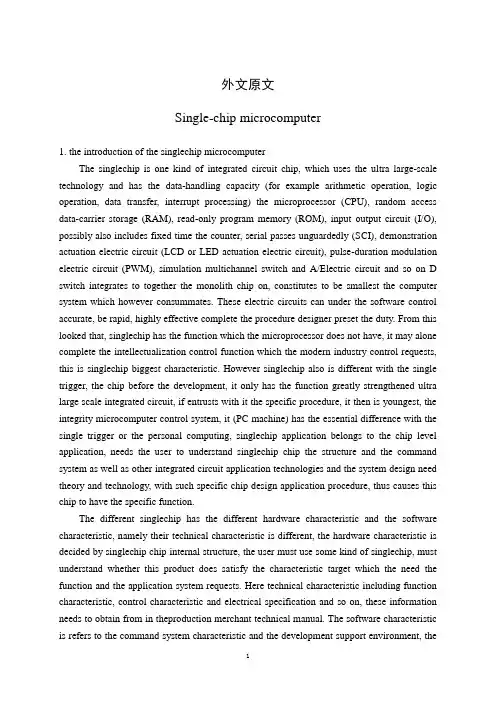
外文原文Single-chip microcomputer1. the introduction of the singlechip microcomputerThe singlechip is one kind of integrated circuit chip, which uses the ultra large-scale technology and has the data-handling capacity (for example arithmetic operation, logic operation, data transfer, interrupt processing) the microprocessor (CPU), random access data-carrier storage (RAM), read-only program memory (ROM), input output circuit (I/O), possibly also includes fixed time the counter, serial passes unguardedly (SCI), demonstration actuation electric circuit (LCD or LED actuation electric circuit), pulse-duration modulation electric circuit (PWM), simulation multichannel switch and A/Electric circuit and so on D switch integrates to together the monolith chip on, constitutes to be smallest the computer system which however consummates. These electric circuits can under the software control accurate, be rapid, highly effective complete the procedure designer preset the duty. From this looked that, singlechip has the function which the microprocessor does not have, it may alone complete the intellectualization control function which the modern industry control requests, this is singlechip biggest characteristic. However singlechip also is different with the single trigger, the chip before the development, it only has the function greatly strengthened ultra large scale integrated circuit, if entrusts with it the specific procedure, it then is youngest, the integrity microcomputer control system, it (PC machine) has the essential difference with the single trigger or the personal computing, singlechip application belongs to the chip level application, needs the user to understand singlechip chip the structure and the command system as well as other integrated circuit application technologies and the system design need theory and technology, with such specific chip design application procedure, thus causes this chip to have the specific function.The different singlechip has the different hardware characteristic and the software characteristic, namely their technical characteristic is different, the hardware characteristic is decided by singlechip chip internal structure, the user must use some kind of singlechip, must understand whether this product does satisfy the characteristic target which the need the function and the application system requests. Here technical characteristic including function characteristic, control characteristic and electrical specification and so on, these information needs to obtain from in theproduction merchant technical manual. The software characteristic is refers to the command system characteristic and the development support environment, theinstruction characteristic is singlechip addressing way which we is familiar with, the data processing and the logical processing way, input-output characteristic and to power source request and so on. The development support environment is compatible and the probability including the instruction, supports the software (to contain may support development application procedure software resources) and the hardware resources. Must use some model singlechip to develop own application system, master its structure characteristic and the technical characteristic is that we need.. Singlechip control system could substitute for before uses control system which the complex electronic circuit or the digital circuit constituted, might the software control realizes, and could realize the intellectualization, now singlechip control category omnipresent, for example correspondence product, domestic electric appliances, intelligent instrument measuring appliance, process control and special-purpose control device and so on, singlechip application domain was more and more widespread. Indeed, singlechip application significance is far is not restricted in its application category or from this the economic efficiency which brings, it fundamentally changed the traditional control method and the design thought more importantly. Is controls technical a revolution, is an important milestone.2.The MCU’s development outlineIn 1946 first electronic accounting machine birth until now, only then 50 years, depends upon microelectronic technology and the semiconductor technology progress, from the electron tube - transistor- integrated circuit - large scale integrated circuit, now together on the chip definitely may integrate several million even more than ten million transistor, causes the computer volume slightly, the function is stronger. Specially in the nearly 20 years time, computer technology obtained the rapid development, the computer in the industry and agriculture, the scientific research, the education, the national defense and the aerospace domain has obtained the widespread application, computer technology already was a national modern science and technology level important symbol.Singlechip is born in the 20th century 70's, looks like F8 monolithic microcomputer which Fairchid Corporation develops. The so-called singlechip is uses the large scale integrated circuit technology the central processing element (Center Processing Unit, Also is Chang Cheng CPU) and the data-carrier storage (RAM), theprogram memory (ROM) and other I/O passes integrates unguardedly on together the chip, constitutes a smallest computer system, but modern singlechip then has added on the severance unit, fixed time unit and A/D transformation and so on more complex, more perfect electric circuit, causes singlechip the function more and more formidable, the application is more widespread.The 20th century 70's, microelectronic technology is being at the development phase, theintegrated circuit belongs to the scale development time, each kind of new material new craft not yet mature, singlechip still occupied the primary development phase, the part integration scale also quite small, the function quite was simple, CPU, RAM had generally has also included some simple I/O integrates to the chip on, looks like Farichild Corporation to belong to this type, it also must be joined to the periphery other processing electric circuits just now to constitute the integrity the computing system. The similar singlechip also has Zilog Corporation the Z80 microprocessor. In 1976 INTEL Corporation has promoted the MCS-48 singlechip, this time singlechip is the genuine 8 monolithic microcomputers, and pushes to the market. It is young by the volume, function entire, the price has lowly won the widespread application, has laid the foundation for singlechip development, becomes in singlechip history the important milestone. Under the MCS-48 leadership, after that, each big semiconductor company developed and has developed own singlechip one after another, looked like Zilog Corporation the Z8 series.To the beginning of the 80's, singlechip has developed to the high performance stage, looks like INTEL Corporation the MCS-51 series, Motorola Corporation 6,801 and 6,802 series, Rokwell Corporation 6,501 and 6,502 series and so on, In addition,Japan's famous electrical company NEC and HITACHI all one after another developed had oneself characteristic the special-purpose singlechip. The 80's, world each big company competes to develop the variety multi-purpose strong singlechip, some severaldozens series, more than 300 varieties, this time singlechip belongs approximately truely monolithic, mostly integrated CPU, RAM, ROM, number many I/O connection, many kinds of interruption system, even also has some to bring A/D switch singlechip, function more and more formidable, RAM and ROM capacity also more and more big, the addressing space even may reach 64kB, may say, singlechip developed to a brand-new stage, the application domain has beenmore widespread, many domestic electric appliances moved towards the intellectualized development path which controlled using singlechip. After 1982, 16 singlechips are published, represent the product are INTEL Corporation's MCS-96 series, 16 singlechips compare 8 machine, the data width increased a time, real-time processing ability stronger, the basic frequency is higher, the integration rate had achieved 120,000 transistors, RAM increased to 232 bytes, ROM then has achieved 8kB, and had 8 interrupt sources, at the same time has disposed multichannel A/D transformation channel, high speed I/The O processing unit, is suitable for the more complex control system.After 90's, singlechip obtained the rapid development, the world each big semiconductor company has developed a function more formidable singlechip one after another. American Microchip Corporation had issued one kind of incompatible MCS-51 newgeneration of PIC series singlechip, has aroused the field widespread interest completely, its product only then 33 simplified the set of instructions to attract many users specially, caused the people to concentrate from the INTEL 111 complex instructions. The PIC singlechip has obtained the fast development, holds the small space in the field. The afterwards matter, the familiar singlechip public figures quite have been all clear, more monolithic aircraft types pour out, MOTOROLA Corporation had issued one after another the MC68HC series singlechip, Japan's several famous companies all developed a performance stronger product, but Japan's singlechip used in generally the special-purpose systems control, but did not look like company and so on INTEL puts in to the market forms the general singlechip. For example NEC Corporation produces the uCOM87 series singlechip, its representative works uPC7811 is one kind of performance quite outstanding singlechip. MOTOROLA Corporation's characteristic and so on MC68HC05 series its high speed low price has won many users. Zilog Corporation's Z8 series product representative works are Z8671, contains BASIC the Debug interpreter, enormous place then user. But American country half COP800 series singlechip then uses the advanced Harvard structure. ATMEL Corporation then perfectly unifies singlechip technology and the advanced Flash memory technology, has issued the performance quite outstanding AT89 series singlechip. Including company and so on China's Taiwan HOLTEK and WINBOND in abundance has also joined singlechip development ranks, by reason of their inexpensive superiority, shares cup of beautiful thick soup.In 1990 American INTEL Corporation promoted 80,960 super 32 singlechips to cause the computer stir, the product has put in the market one after another, became in singlechip history an important milestone. This period, in singlechip field, singlechip variety extraordinary splendour, competes to be the most unusual. Some 8, 16 even 32 machine, but 8 singlechips by its price inexpensive, the variety complete, the application software rich, the support environment were still full, characteristic and so on development convenience but are occupying the dominant position. But INTEL Corporation by reason of their abundant technology, the performance outstanding type and the good foundation, at present was still singlechip mainstream product. Only is the 90's intermediate stages, INTEL Corporation is busy is developing their personal computing microprocessor, not the enough energy continued singlechip technology which develops oneself creates leads, but by company and so on PHILIPS continues to develop the C51 series singlechip.3.Singlechip application domainSinglechip widely applies in the instrument measuring appliance, the domestic electric appliances, the medical equipment, domain and so on aerospace, special purpose equipment intellectualized management and process control, may divide the following several categoriesapproximately:(1). On intelligent instrument measuring appliance applicationSinglechip has the volume small, the power loss low, the control function strong, the expansion is nimble, merit and so on microminiaturization and easy to operate, widely applies in the instrument measuring appliance, the union different type sensor, may realize such as physical quantity the and so on voltage, power, frequency, humidity, temperature, current capacity, speed, thickness, angle, length, degree of hardness, element, pressure survey. Uses singlechip control to cause the instrument measuring appliance digitization, the intellectualization, the microminiaturization, also the function compares uses the electron or the digital circuit is more formidable. For example precise measurement equipment (dynamometer, oscilloscope, each kind of analyzer).(2). In industry control applicationMay constitute the various formats control system, the data acquisition system with singlechip. For example the factory assembly line intellectualized management, the elevator intellectualization control, each kind of alarm system, constitutes two cascade control systems with the computer networking and so on.(3).In domestic electric appliances applicationMay say like this that, the present domestic electric appliances basically have all used singlechip control, praised, the washer, the electric refrigerator, the air conditioner, the color television, other acoustic video frequency equipments from the electricity food, again to the electronic weighting equipment, all kinds of, omnipresent.(4).In computer network and correspondence domain applicationOf the modern singlechip has the correspondence connection generally, may very conveniently and the computer carries on the data communication,for provided the extremely good physical conditions application in between the computer network and the communication facility, the present communication facility basically has all realized singlechip intelligence control, from the handset, the telephone, the small program controlled switch, the building automatic correspondence ringing system, the train wireless correspondence, again the mobile phone which everywhere to the routine work in, the colony mobile communication, radio intercom and so on.(5).Singlechip in medical equipment domain applicationSinglechip quite is also widespread inmedical equipment use, for example medical life-support machine, each kind of analyzer, , ultrasound diagnosis equipment and hospital bed ringing system and so on. In addition, singlechip in the industry and commerce, the finance, the scientific research, the education, domain and so on national defense aerospaceall has the extremely widespread use.4.Singlechip development tendencyNow may say singlechip was all flowers blooms together, the time which hundred school of thought contended, in the world each big chip manufacture company has all promoted own singlechip, from 8, 16 to 32, innumerable, had everything expected to find, has compatibly with the mainstream C51 series, also had not not compatibly, but they unique, became mutually supplementarily, provided the broad world for singlechip application. Looks over singlechip developing process, may indicate singlechip development tendency, has approximately:(1). Low power loss CMOSThe MCS-51 series 8,031 promotes when the power loss reaches 630mW, but the present singlechip all about 100mW, along with more and more is generally low to singlechip power loss request, the present each singlechip manufacturer basic has all used CMOS (complementary metal oxide semiconductor craft). Looked like80C51 to use HMOS (namely high density metal oxide compound semiconductor craft) and CHMOS (supplementary high density metal oxide compound semiconductor craft). CMOS although power loss low, but because its physical characteristic decides its working speed insufficiently high, but CHMOS then had has been high speed and the low power loss characteristic, these characteristics, suited in are requesting the low power loss likely battery power supply the application situation. Therefore this kind of craft will be the main way which the next section of times singlechip will develop.(2). Miniature monolithicNow the conventional singlechip all is generally the central processor (CPU), the random access data storage (RAM), the read-only program memory (ROM), parallel and the serial communication connection, the interruption system, the timing circuit, the clock electric circuit integration on together the sole chip, the enlargement mode singlechip integrated like A/The D switch, PMW (pulse-duration modulation electric circuit), WDT (watch-dog), some singlechips (liquid crystal) actuate LCD the electric circuit all to integrate on the sole chip, such singlechip contains unit electric circuit more, the function is more formidable. Even singlechip merchant also may act according to the user requiremnet the body custom make, makes has oneself characteristic singlechip chip. In addition, present product universal demand volume small, weight light, this requests singlechip strong and the power loss is low besides the function, but also requests its volume to have to be small. Present many singlechips all have the many kinds of seals form, SMD (superficial seal) more and more receives welcome, to enable the system which constitutes by singlechip towards themicrominiaturized direction to develop.(3).Mainstream and multi- varieties coexistenceNow although singlechip variety is many, unique, but still as the core singlechip occupies the mainstream take 80C51, the compatible its structure and the command system have PHILIPS Corporation the product, the ATMEL Corporation's product and the Chinese Taiwan's Winbond series singlechip. Therefore C8051 was the core singlechip occupied the half of the country. But Microchip Corporation's PIC simplified the set of instructions (RISC) also to have the strong development tendency, the Chinese Taiwan's HOLTEK Corporation recent years singlechip output grows day by day, if the low price nature superior superiority, occupied a certain market minute volume. In addition also has MOTOROLA Corporation the product, the Japaneseseveral big companies' special-purpose singlechips. In the certain time, this kind of situation will be able to continue, will not have the monopoly aspect which some singlechip unified, will walk will be depends on for existence supplementarily, will complement one another, the communal development path.中文翻译单片机1. 单片机介绍单片机是一种集成电路芯片,应用超大规模技术把具有数据处理能力(如算术运算,逻辑运算、数据传送、中断处理)的微处理器(CPU),随机存取数据存储器(RAM),只读程序存储器(ROM),输入输出电路(I/O口),可能还包括定时计数器,串行通信口(SCI),显示驱动电路(LCD 或 LED 驱动电路),脉宽调制电路(PWM),模拟多路转换器A/D 转换器等电路集成到一块单块芯片上,构成一个最小然而完善的计算机系统。
单片机的外文文献及中文翻译一、外文文献Title: The Application and Development of SingleChip Microcontrollers in Modern ElectronicsSinglechip microcontrollers have become an indispensable part of modern electronic systems They are small, yet powerful integrated circuits that combine a microprocessor core, memory, and input/output peripherals on a single chip These devices offer significant advantages in terms of cost, size, and power consumption, making them ideal for a wide range of applicationsThe history of singlechip microcontrollers can be traced back to the 1970s when the first microcontrollers were developed Since then, they have undergone significant advancements in technology and performance Today, singlechip microcontrollers are available in a wide variety of architectures and capabilities, ranging from simple 8-bit devices to complex 32-bit and 64-bit systemsOne of the key features of singlechip microcontrollers is their programmability They can be programmed using various languages such as C, Assembly, and Python This flexibility allows developers to customize the functionality of the microcontroller to meet the specific requirements of their applications For example, in embedded systems for automotive, industrial control, and consumer electronics, singlechip microcontrollers can be programmed to control sensors, actuators, and communication interfacesAnother important aspect of singlechip microcontrollers is their low power consumption This is crucial in batterypowered devices and portable electronics where energy efficiency is of paramount importance Modern singlechip microcontrollers incorporate advanced power management techniques to minimize power consumption while maintaining optimal performanceIn addition to their use in traditional electronics, singlechip microcontrollers are also playing a significant role in the emerging fields of the Internet of Things (IoT) and wearable technology In IoT applications, they can be used to collect and process data from various sensors and communicate it wirelessly to a central server Wearable devices such as smartwatches and fitness trackers rely on singlechip microcontrollers to monitor vital signs and perform other functionsHowever, the design and development of systems using singlechip microcontrollers also present certain challenges Issues such as realtime performance, memory management, and software reliability need to be carefully addressed to ensure the successful implementation of the applications Moreover, the rapid evolution of technology requires developers to constantly update their knowledge and skills to keep up with the latest advancements in singlechip microcontroller technologyIn conclusion, singlechip microcontrollers have revolutionized the field of electronics and continue to play a vital role in driving technological innovation Their versatility, low cost, and small form factor make them an attractive choice for a wide range of applications, and their importance is expected to grow further in the years to come二、中文翻译标题:单片机在现代电子领域的应用与发展单片机已成为现代电子系统中不可或缺的一部分。
Microcomputer SystemsElectronic systems are used for handing information in the most general sense; this information may be telephone conversation, instrument read or a company’s accounts, but in each case the same main type of operation are involved: the processing, storage and transmission of information. in conventional electronic design these operations are combined at the function level; for example a counter, whether electronic or mechanical, stores the current and increments it by one as required. A system such as an electronic clock which employs counters has its storage and processing capabilities spread throughout the system because each counter is able to store and process numbers.Present day microprocessor based systems depart from this conventional approach by separating the three functions of processing, storage, and transmission into different section of the system. This partitioning into three main functions was devised by V on Neumann during the 1940s, and was not conceived especially for microcomputers. Almost every computer ever made has been designed with this structure, and despite the enormous range in their physical forms, they have all been of essentially the same basic design.In a microprocessor based system the processing will be performed in the microprocessor itself. The storage will be by means of memory circuits and the communication of information into and out of the system will be by means of special input/output(I/O) circuits. It would be impossible to identify a particular piece of hardware which performed the counting in a microprocessor based clock because the time would be stored in the memory and incremented at regular intervals but the microprocessor. However, the software which defined the system’s behavior woul d contain sections that performed as counters. The apparently rather abstract approach to the architecture of the microprocessor and its associated circuits allows it to be very flexible in use, since the system is defined almost entirely software. The design process is largely one of software engineering, and the similar problems of construction and maintenance which occur in conventional engineering are encountered when producing software.The figure1.1 illustrates how these three sections within a microcomputer are connected in terms of the communication of information within the machine. The system is controlled by the microprocessor which supervises the transfer of information between itself and the memory and input/output sections. The external connections relate to the rest (that is, the non-computer part) of the engineering system.Fig.1.1 Three Sections of a Typical MicrocomputerAlthough only one storage section has been shown in the diagram, in practice two distinct types of memory RAM and ROM are used. In each case, the word ‘memory’ is rather inappropriate since a computers memory is more like a filing cabinet in concept; information is stored in a set of numbered ‘boxes’ and it is referenced by the serial number of the ‘box’ in questio n.Microcomputers use RAM (Random Access Memory) into which data can be written and from which data can be read again when needed. This data can be read back from the memory in any sequence desired, and not necessarily the same order in which it was w ritten, hence the expression ‘random’ access memory. Another type of ROM (Read Only Memory) is used to hold fixed patterns of information which cannot be affected by the microprocessor; these patterns are not lost when power is removed and are normally used to hold the program which defines the behavior of a microprocessor based system. ROMs can be read like RAMs, but unlike RAMs they cannot be used to store variable information. Some ROMs have their data patterns put in during manufacture, while others are programmable by the user by means of special equipment and are called programmable ROMs. The widely used programmable ROMs are erasable by means of special ultraviolet lamps and are referred to as EPROMs, short for Erasable Programmable Read Only Memories. Other new types of device can be erased electrically without the need for ultraviolet light, which are called Electrically Erasable Programmable Read Only Memories,EEPROMs.The microprocessor processes data under the control of the program, controlling the flow of information to and from memory and input/output devices. Some input/output devices are general-purpose types while others are designed for controlling special hardware such as disc drives or controlling information transmission to other computers. Most types of I/O devices are programmable to some extent, allowing different modes of operation, while some actually contain special-purpose microprocessors to permit quite complex operations to be carried out without directly involving the main microprocessor.The microprocessor , memory and input/output circuit may all be contained on the same integrated circuit provided that the application does not require too much program or data storage . This is usually the case in low-cost application such as the controllers used in microwave ovens and automatic washing machines . The use of single package allows considerable cost savings to e made when articles are manufactured in large quantities . As technology develops , more and more powerful processors and larger and larger amounts of memory are being incorporated into single chip microcomputers with resulting saving in assembly costs in the final products . For the foreseeable future , however , it will continue to be necessary to interconnect a number of integrated circuits to make a microcomputer whenever larger amounts of storage or input/output are required.Another major engineering application of microcomputers is in process control. Here the presence of the microcomputer is usually more apparent to the user because provision is normally made for programming the microcomputer for the particular application. In process control applications the benefits lf fitting the entire system on to single chip are usually outweighed by the high design cost involved, because this sort lf equipment is produced in smaller quantities. Moreover, process controllers are usually more complicated so that it is more difficult to make them as single integrated circuits. Two approaches are possible; the controller can be implemented as a general-purpose microcomputer rather like a more robust version lf a hobby computer, or as a ‘packaged’ system, signed for replacing controllers based on older technologies such as electromagnetic relays. In the former case the system wouldprobably be programmed in conventional programming languages such as the ones to9 be introduced later, while in the other case a special-purpose language might be used, for example one which allowed the function of the controller to be described in terms of relay interconnections, In either case programs can be stored in RAM, which allows them to be altered to suit changes in application, but this makes the overall system vulnerable to loss lf power unless batteries are used to ensure continuity of supply. Alternatively programs can be stored in ROM, in which case they virtually become part of the electronic ‘hardware’ and are often referred to as firmware.More sophisticated process controllers require minicomputers for their implementation, although the use o f large scale integrated circuits ‘the distinction between mini and microcomputers, Products and process controllers of various kinds represent the majority of present-day microcomputer applications, the exact figures depending on one’s interpretation of the word ‘product’. Virtually all engineering and scientific uses of microcomputers can be assigned to one or other of these categories. But in the system we most study Pressure and Pressure Transmitters. Pressure arises when a force is applied over an area. Provided the force is one Newton and uniformly over the area of one square meters, the pressure has been designated one Pascal. Pressure is a universal processing condition. It is also a condition of life on the planet: we live at the bottom of an atmospheric ocean that extends upward for many miles. This mass of air has weight, and this weight pressing downward causes atmospheric pressure. Water, a fundamental necessity of life, is supplied to most of us under pressure. In the typical process plant, pressure influences boiling point temperatures, condensing point temperatures, process efficiency, costs, and other important factors. The measurement and control of pressure or lack of it-vacuum-in the typical process plant is critical.单片机控制系统广义地说,微型计算机控制系统(单片机控制系统)是用于处理信息的,这种被用于处理的信息可以是电话交谈,也可以是仪器的读数或者是一个企业的帐户,但是各种情况下都涉及到相同的主要操作:信息的处理、信息的存储和信息的传递。